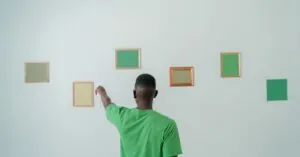Sculptural decor pieces are the unsung heroes of interior design, effortlessly transforming bland spaces into vibrant showcases of personality. Imagine walking into a room where a whimsical giraffe sculpture steals the spotlight, making guests chuckle while simultaneously raising their eyebrows in admiration. These artistic wonders don’t just sit pretty; they spark conversations, inspire creativity, and can even distract from that questionable stain on the carpet.
In a world where minimalism often reigns supreme, sculptural decor pieces invite a playful rebellion. They add depth and texture, turning ordinary corners into extraordinary experiences. Whether it’s a sleek modern piece or a quirky vintage find, these sculptures breathe life into any space. So, why settle for the mundane when you can elevate your home with a dash of artistry? Dive into the world of sculptural decor and discover how to make your space not just livable, but unforgettable.
Table of Contents
ToggleOverview of Sculptural Decor Pieces
Sculptural decor pieces serve as distinct focal points in interior design. These artistic elements enhance the aesthetic appeal and establish a unique identity within any space. Designers often select materials such as wood, metal, glass, and ceramics when creating these pieces. Each material offers different textures and finishes, contributing to the overall atmosphere of the room.
Sizes of sculptural decor pieces vary significantly, from small tabletop sculptures to large floor installations. This versatility allows decorators to tailor their choices based on the scale of the space. Bold pieces command attention and serve as conversation starters, while smaller sculptures can accentuate subtle details.
Shapes of these decor items also differ, ranging from abstract forms to recognizable figures. When integrated thoughtfully, sculptural pieces harmonize with existing decor and furniture. The interplay of curves and angles adds dynamism, making the space more visually engaging.
Placement matters significantly for maximizing the impact of sculptural decor. Positioning a sculpture in a well-lit area highlights its features and enhances its visual appeal. Grouping multiple pieces creates a gallery effect, inviting exploration and admiration.
Color selection plays a crucial role in the effectiveness of sculptural decor. Neutral tones offer sophistication and elegance, while vibrant colors inject energy and excitement into a space. Keeping the overall color palette in mind helps maintain cohesion throughout the room.
Sculptural decor pieces redefine traditional decor methods by encouraging creativity and individual expression. By selecting unique elements, decorators can craft environments that resonate with personality and style, ultimately transforming the ordinary into the extraordinary.
Types of Sculptural Decor Pieces
Sculptural decor pieces come in various forms, adding uniqueness and character to spaces. Each type serves a distinct purpose and contributes to the overall aesthetic.
Wall Art Sculptures
Wall art sculptures elevate vertical spaces through dynamic designs. These pieces range from relief sculptures to intricate three-dimensional forms. Artists often use materials like metal, wood, and resin to create varied textures. Notable examples include abstract shapes that infuse movement or landscapes that evoke nature. Strategic placement on walls draws attention, fostering visual interest in otherwise plain areas.
Tabletop Sculptures
Tabletop sculptures serve as striking accents on surfaces like coffee tables, desks, or shelves. Sizes and designs can vary from miniature figures to bold, eye-catching representations. Materials such as ceramic, glass, and stone often enhance the artistic image. Many tabletop pieces might reflect themes tied to personal interests or nature. Correctly positioned, these sculptures provide focal points, stimulating conversation and intrigue.
Floor Sculptures
Floor sculptures make significant statements due to their size and presence. These large installations demand attention, with styles varying from abstract to figurative forms. Typical materials include metal, stone, and wood, often complementing interior design. These pieces can create visual balance within a room or serve as central features. Proper placement in open areas maximizes their impact, transforming the environment into an engaging space.
Materials Used in Sculptural Decor
Sculptural decor pieces utilize a variety of materials, each enhancing the visual and tactile experience in a space.
Metal Sculptures
Metal sculptures often showcase durability and elegance. They can vary from sleek modern designs to intricate vintage forms. Stainless steel offers a contemporary shine, while wrought iron provides a rustic charm. Bronze features rich coloring with a timeless appeal. Many artists incorporate mixed metals to create unique contrasts and textures. Their reflective surfaces interact beautifully with light, making them eye-catching focal points. Metal sculptures frequently find their place both indoors and outdoors, withstanding different weather conditions while enhancing the surroundings.
Wood Sculptures
Wood sculptures bring warmth and organic beauty to any environment. Designers often use hardwoods for their rich grains and resilience. Softwoods can also produce stunning results with lighter, airy designs. Each wood type carries its own character, allowing for varied finishes from polished to distressed looks. Natural shapes mimic the forms found in nature, inviting a sense of tranquility. Unique craftsmanship leads to one-of-a-kind pieces that tell a story. Pieces made from reclaimed wood offer an eco-friendly option, adding a layer of sustainability while making strong artistic statements.
Stone Sculptures
Stone sculptures exhibit strength and permanence in their artistic expression. Marble, known for its smooth elegance, frequently graces museums and galleries. Granite provides a rugged finish, suitable for outdoor installations. Sculptors often favor limestone for its malleable properties, enabling intricate detailing. Different textures and colors in stone can evoke various emotions, enriching the overall aesthetic. Durability makes these sculptures ideal for gardens or entryways, standing the test of time. Many stone pieces symbolize stability, making them impactful additions to both residential and commercial spaces.
How to Incorporate Sculptural Decor in Your Home
Sculptural decor enhances a home’s aesthetic and atmosphere. By thoughtfully placing these pieces, one can create a unique and inviting space.
Living Room Ideas
Transform the living room with striking sculptures that capture attention. Large floor sculptures positioned near seating areas act as conversation starters. Tabletop sculptures on coffee tables bring personal themes to the forefront. Consider wall art sculptures that elevate vertical spaces, adding depth and character. When selecting colors, balance vibrant pieces against neutral backdrops for a dynamic effect. Lighting also plays a role, so positioning sculptures under soft illumination enhances their impact.
Bedroom Ideas
Incorporate sculptural decor in bedrooms for a serene ambiance. Choose subtle tabletop sculptures on nightstands to reflect personal style without overwhelming the space. Wall art sculptures can create a focal point above the headboard, drawing the eye upward. For added interest, consider sculptures made from natural materials, which promote tranquility. Use earthy tones or soft colors to harmonize with bedding, ensuring that the decor complements the overall aesthetic. Thoughtful arrangement fosters a peaceful retreat, inviting relaxation and creativity.
Sculptural decor pieces are more than just decorative elements; they embody creativity and personal expression. By introducing these artistic forms into a space, individuals can create an environment that reflects their unique style and invites engagement. Whether through striking floor installations or subtle tabletop accents, these pieces offer endless possibilities for enhancing aesthetic appeal.
The thoughtful integration of sculptural decor can transform any room into a vibrant showcase. As designers continue to explore various materials and shapes, the potential for innovative decor expands. Embracing sculptural decor not only elevates interior design but also fosters a sense of individuality and warmth in every home.




